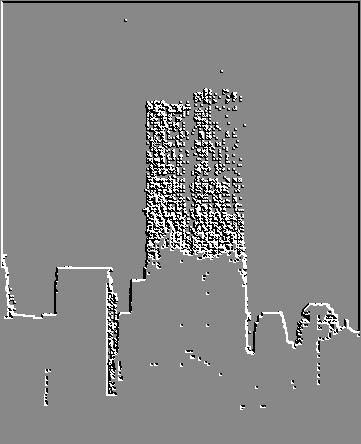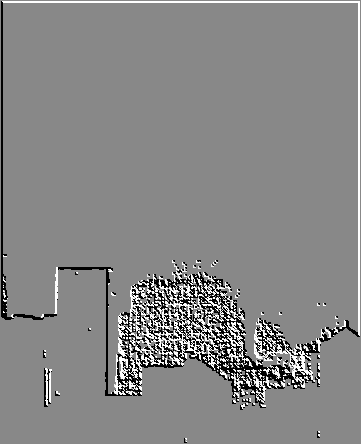The World
Trade Center
Part II

For some four years, a friend daily rode an early ferry to Manhattan. He often reflected on the oddly rootless, alienating quality of the World Trade Center. Recently, he was horrified by his instinctive response to films of the skyline after the fall of the World Trade Center. He found beauty and harmony restored by the towers' absence. They had merely been big buildings, not great buildings such as the Chrysler, Empire State or Woolworth buildings.
To be sure, mere size does not make a building inhumane. Buildings as large as St. Peter's Basilica in Rome or St. Paul's Cathedral in London retain humanity in their proportions, perhaps because they were designed to exist in an harmonious relation with the society that created them. In the case of cathedrals, they glorified something greater than man, and at least half of the idea of building their spires ever higher was that the created might reach closer to his Creator.
The World Trade Center, despite its Gothic touches, glorified only power. And, by God, its towers became symbols of power on September 11. In the moments between the first and second attacks, one saw the compelling, powerful image of a symbol of power with a great gaping hole. For all our horrified wonderment at the scale, timing and organization of the attack, the buildings were nonetheless destroyed by men who simply stole airplanes --- using ingenuity and intelligence to overcome the security systems that, though able to make airplane travel obnoxious, could not prevent a group of people utterly dedicated to the destruction of the society represented by those buildings from their obscene and symbolic act.
Minoru Yamasaki, the Center's architect, had supposedly claimed the towers were engineered to withstand the impact of a Boeing 747. His calculations, like his personality, were a little off.
He designed the Pruitt-Igoe public housing project in St. Louis, which was built in 1955 and entirely leveled by implosion in July 1972. One can only note that the local politicians, probably not profound aesthetes, seriously held the buildings themselves were alienating: that they somehow actually encouraged criminal behavior. Like the terrorists who destroyed his most famous project, Yamasaki apparently viewed, as Eric Darton wrote, "living processes in general, and social life in particular, with a high degree of abstraction," perhaps seeing the people who used his buildings as so many ants.
 Yet Yamasaki had a keen business sense. The Port Authority was obsessed by maximizing the rentable square footage of the towers. He did this by discarding the conventional interior support columns: the steel framework used in older buildings, such as that permitting the Empire State Building to survive the crash of a B-25 bomber into its upper floors in 1945. Rather, Yamasaki suspended the towers from their own skins and from the core columns containing the buildings' machinery: air conduits, electric and telecommunications cables, and water pipes. This meant that, on September 11, once the buildings' envelopes were violated and the burning jet fuel swiftly melted the steel supports linking the upper floors with the walls, the towers pancaked within 90 minutes because they could no longer support themselves.
Yet Yamasaki had a keen business sense. The Port Authority was obsessed by maximizing the rentable square footage of the towers. He did this by discarding the conventional interior support columns: the steel framework used in older buildings, such as that permitting the Empire State Building to survive the crash of a B-25 bomber into its upper floors in 1945. Rather, Yamasaki suspended the towers from their own skins and from the core columns containing the buildings' machinery: air conduits, electric and telecommunications cables, and water pipes. This meant that, on September 11, once the buildings' envelopes were violated and the burning jet fuel swiftly melted the steel supports linking the upper floors with the walls, the towers pancaked within 90 minutes because they could no longer support themselves.
The walls consisted of alternating surfaces: 18 inches of metal and 22 inches of glass. This created the towers' least humane quality: their oddly narrow windows, "projecting an image that seems more radiator than building," as John Tauranac wrote, that made them seem windowless at a distance of only a few blocks. Until the sickening moment when the towers began to fall, one could not comprehend the damage because the building was incomprehensible.
Now one can comprehend it. At dawn on September 11, 2001, the World Trade Center's towers were 110 stories tall. Their remains on September 12 piled about ten stories high.
--- William Bryk
©2003The New York Press

 Yet Yamasaki had a keen business sense. The Port Authority was obsessed by maximizing the rentable square footage of the towers. He did this by discarding the conventional interior support columns: the steel framework used in older buildings, such as that permitting the Empire State Building to survive the crash of a B-25 bomber into its upper floors in 1945. Rather, Yamasaki suspended the towers from their own skins and from the core columns containing the buildings' machinery: air conduits, electric and telecommunications cables, and water pipes. This meant that, on September 11, once the buildings' envelopes were violated and the burning jet fuel swiftly melted the steel supports linking the upper floors with the walls, the towers pancaked within 90 minutes because they could no longer support themselves.
Yet Yamasaki had a keen business sense. The Port Authority was obsessed by maximizing the rentable square footage of the towers. He did this by discarding the conventional interior support columns: the steel framework used in older buildings, such as that permitting the Empire State Building to survive the crash of a B-25 bomber into its upper floors in 1945. Rather, Yamasaki suspended the towers from their own skins and from the core columns containing the buildings' machinery: air conduits, electric and telecommunications cables, and water pipes. This meant that, on September 11, once the buildings' envelopes were violated and the burning jet fuel swiftly melted the steel supports linking the upper floors with the walls, the towers pancaked within 90 minutes because they could no longer support themselves.